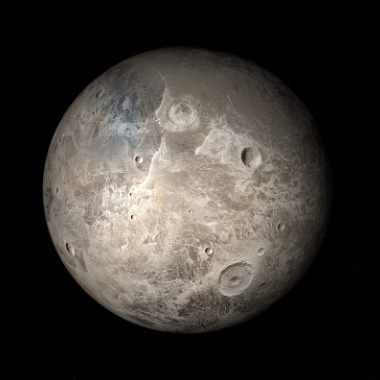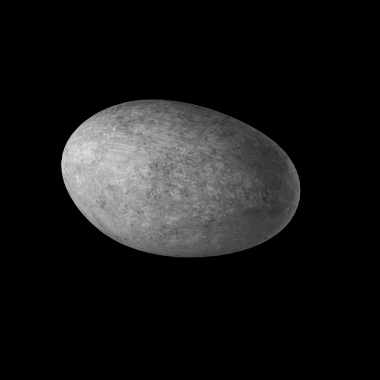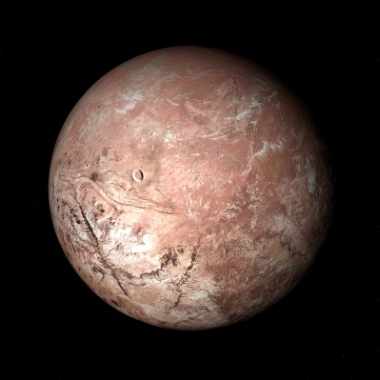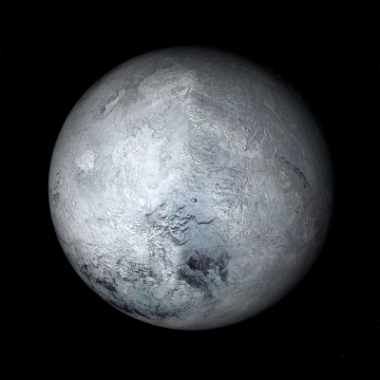There are five dwarf planets in the solar system, they are Ceres, Pluto, Haumea, Makemake, and Eris. They’re all found in different parts of our galaxy except for one which is located at an asteroid belt near Earth’s orbit. Dwarf planets are a fascinating subject and there is still so much to learn about them. There may be more than 10,000 of these objects in our solar system alone! Scientists have only gotten close enough to two Ceres, which was visited by NASA’s Dawn mission in 2015; and Pluto, with the New Horizons probe making its way towards it back in 2006.
Dwarf Planet Facts
- There are five official dwarf planets
- More than 10,000 objects could be classed as dwarf planets
- Pluto was reclassified a dwarf planet in 2006 from a planet
- Dwarf planets have enough mass to be round
- Ceres was discovered in 1801
- Ceres is the closest dwarf planet to the sun
- Pluto is the largest of the dwarf planets
- Hygiea is the smallest dwarf planet
- Dwarf planets were first classified in 2006
- Haumea is one of the fastest rotating masses large in our solar system
What is Dwarf Planet?
Dwarf planets share many of the same characteristics as regular, big-time planets. But there’s one significant difference: The International Astronomical Union defines a dwarf planet is any celestial body that
A. orbits around our Sun; and
B. has sufficient mass for its self gravitation to render it spherical. So unlike most other celestial bodies in space which are round by default, these guys have got some major gravitational pull going on beneath their surface.
C. has not cleared the neighborhood around its orbit, and
D. is not a satellite.
The key difference between a planet and dwarf planets is that the former has cleared all of its neighboring objects from their orbits while entities such as dwarf planets have not.
This definition means that there are over 10,000 dwarf planets in our solar system, and they’re all orbiting the Sun! What’s more. Dwarf planet status isn’t permanent. It can change into another type of celestial body if it clears out of its orbit or becomes a moon for one of the big-time planets out there.
Sizes of the Dwarf Planets
The largest dwarf planet in the solar system is Pluto followed by Eris, Makemake, Haumea. Ceres has a diameter of about 1400 km less than Pluto!
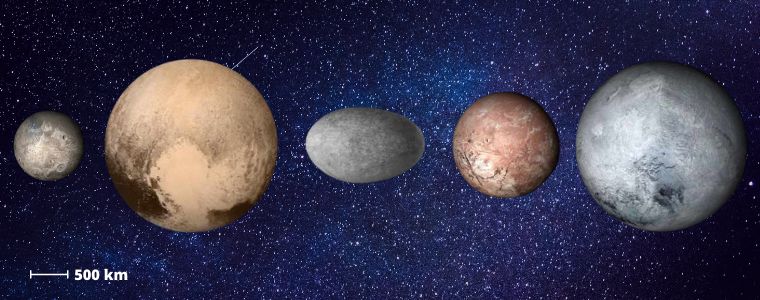
The dwarf planets are positioned in a specific order from closest to the sun, outwards. Starting with Ceres at 2.8 AU away and moving up to Pluto which is 39.5AU distant. The next 3 planets are Haumea 43AU, Makemake 45.8 AU, Eris being furthest at 68 AU from orbit around the Sun.
| Name | Diameter | Distance from Sun | Length of Year |
|---|---|---|---|
| Ceres | 950 km | 413,700,000 km | 4.6 Earth years |
| Pluto | 2,372 km | 5,874,000,000 km | 248.0 Earth years |
| Haumea | 1,960 – 1,518 × 996 km | 6,452,000,000 km | 283.3 Earth years |
| Makemake | 1,434 × 1,422 km | 6,850,000,000 km | 309.9 Earth years |
| Eris | 2,326 km | 10,120,000,000 km | 560.9 Earth years |
The Dwarf Planets
Get to know the dwarf planets by clicking on their images below!
Pluto Reclassification
The enormity of this distinction between a planet and a dwarf planet had one immediate victim. Ever since its discovery in 1930, Pluto had long been considered the ninth planet of the solar system. That changed with a new definition that was proposed in August 2006 by an International Astronomical Union responsible for planetary and satellite designations that would strip it of that title, leaving it as just another dwarf planet.
The Sun is the center of all things, and Pluto’s orbit around it was so crowded with other celestial objects that they essentially kicked it out of its status as a planet. There is a region outside Neptune where other celestial objects can be found. Known as the Kuiper Belt, this area also includes planetary bodies and comets. Pluto and Eris, the two most famous dwarf planets in our solar system today are actually part of a group we call the Kuiper Belt. It’s true that their orbital paths cross each other!
The orbits of the remaining eight planets are not as chaotic. These don’t cross paths with other celestial bodies, and they always maintain their own orbit that never intersects another planet’s path.
History of the dwarf planet
What was once thought to be the ninth planet in our solar system is now just a dwarf planet. Pluto’s status as one of the planets began crumbling when astronomers discovered more than 1,000 objects orbiting beyond Neptune back in 1992.
The trans-Neptunian Objects (TNOs) are a group of objects in the solar system that orbit our sun beyond Neptune. They vary greatly in size and some have been detected by astronomers, though they’re much smaller than Pluto so their existence has gone largely unnoticed for decades.
When Planets Started To Change
In 2003, astronomers at the Palomar Observatory in California identified a new trans-Neptunian object that was more massive than Pluto. This object also had satellites and it was initially named 2003 UB313. After the discovery of 2003 UB313, astronomers became puzzled as to whether it deserved a planetary designation. The answer was going to be found in its orbit and composition but these things were not known yet.
The IAU was tasked with defining what celestial objects are considered planets. In order to do this, they had a committee of professionals from various fields weigh in on the issue and debate it until all members were satisfied that their own bias didn’t overpower others. The committee expressed their opinions to create a draft resolution on the definition of a planet. The proposal was presented at IAU’s 2006 General Assembly in Prague and is now used by astronomers worldwide! The new revision of the constitution was put to a vote during the Closing Ceremony after much debate from its members, and it passed.
Dwarf Planets Start To Be Named
The General Assembly members unanimously agreed on Resolution B5, which defines the universe as consisting of only eight planets. The Resolution created a new class of celestial objects that were distinct from planets. The definition was crucial in distinguishing the difference between dwarf and full-sized planetary bodies as classified by their gravity, shape, size, and other properties.
The final decision on Pluto’s status was made at the Assembly in 2003 and it is now considered a dwarf planet. After that, they renamed another body of mass UB313 to Eris. The three dwarf planets of Pluto, Eris, and Ceres are the first members of their class. Makemake and Haumea joined the ranks of dwarf planets with their additions to our celestial family of five.
Shrouded In Controversy
The resolution that classifies Pluto as a dwarf planet created an uproar among some scientists.
The third criterion of the Resolution is a controversial one because it can be seen as unfair to judge planets on their proximity to other celestial objects. Planetary scientists have argued that this measure may not take into account an object’s intrinsic qualities and instead rely simply on its location in space, which might unfairly penalize some small bodies due to circumstantial factors such as close proximity with larger ones.
This criterion creates a different standard for an object to be considered a planet, one that is based on size and distance: If something is deemed too small and too far away from the Sun, it cannot be classified as a planet.
Scientists are up in arms about the Resolution, claiming that a dwarf planet should be categorized as “true” planets like gas giants and terrestrial ones.

